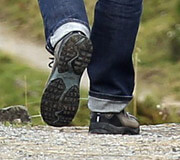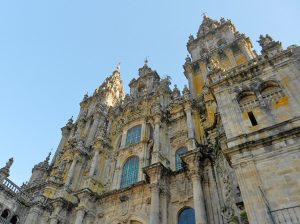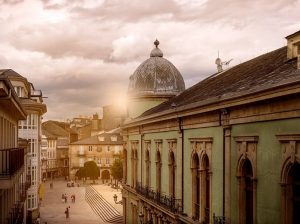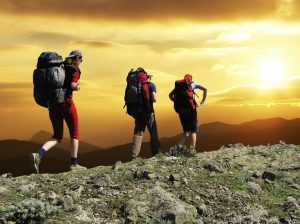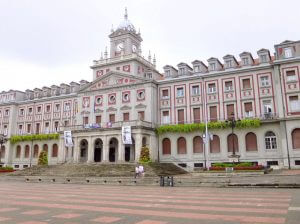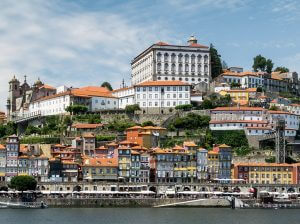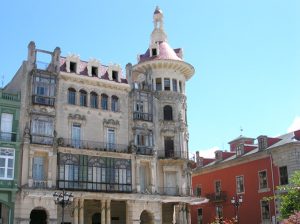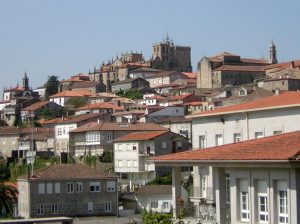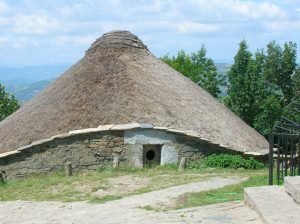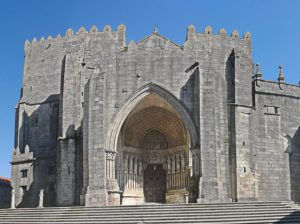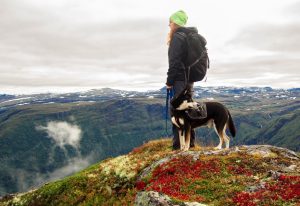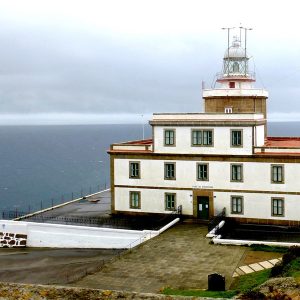Northern Way by bike from Irún
1.780 €You will cycle the distance between Irún and Santiago de Compostela, staying at the accomodations of the Camino at the end of each stage, enjoying a unique experience and experiencing first-hand the history, culture and beauty hidden at every step of this ancient route.
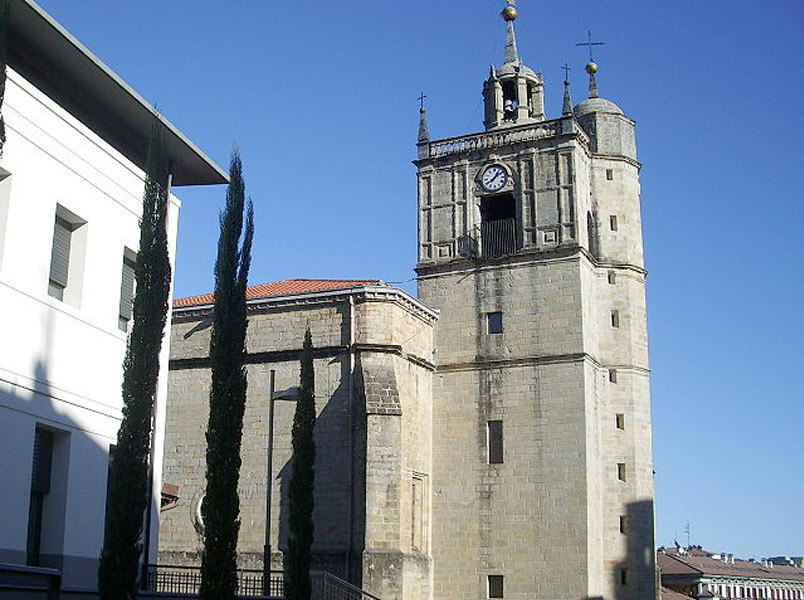
Camino de Santiago from Irún
Route for Pilgrims
Day 1: Arrival at Irún and accomodation
You will arrive in Irun on your own or, if you wish, we can arrange your transfer to Irun from any airport or station you arrive at. This city is the starting point for those pilgrims who begin the Camino de Santiago on the northern slope. From here, depending on the time of arrival, you can visit different points of interest in the area, such as the Town Hall or the San Marcial Chapel.
Day 2: Stage Irún – Zarautz
47 kmOn the way you will pass through the important city of San Sebastián, an obligatory stop to visit some of the city’s best-known points of interest, while enjoying its wide range of gastronomic offerings. You will arrive in Zarautz, where you can visit different points of interest such as the Tower, the Hermitage of San Pedro de Elcano, the Church of Santa María la Real or the Museum of Art and History of Zarautz, which is interesting because its aim is to show part of the history of the Basque coast.
Day 3: Stage Zarautz – Markina
45,8 kmOn the way you will pass through the coastal town of Deba, where you can stop to rest, cool off on the beaches of Santiago or Lapari or walk along its promenades. You will arrive in Markina, where you can visit different points of interest in the area, such as the Patrokua Palace, which houses the tourist office, the Barinaga granary and the Carmen Monumental complex.
Day 4: Stage Markina – Bilbao
56,2 kmOn the way you will pass through Guernica, a town known for its bombing by German and Italian air forces, an event recreated in a painting by Pablo Picasso. All that survived from that day were the Casa de Juntas and the tree of Gernika, considered a symbol of the traditional freedoms of the Basques. You will arrive in Bilbao, today’s destination. This is a city recognised worldwide as an example of urban transformation and home to the Guggenheim Museum. Once here you can relax and enjoy its extensive historical heritage, its great variety of tourist resources and its wide range of gastronomy. Some of the points of interest in the city are the Cathedral of Santiago de Bilbao, the Atxuri station, the Basilica of the Virgin Begoña or the Chávarri Palace.
Day 5: Stage Bilbao – Castro Urdiales
47 kmMake a stop along the way in the town of Pobeña to visit the Barbadún Estuary Protected Natural Area or take a walk along the coast, from where you can see the town’s beach, La Arena beach, and admire the sharp cliffs typical of the Basque coast. You will leave the Basque Country behind to enter Cantabria. You will arrive in Castro Urdiales, where you can visit different points of interest in the area, such as the Casa de los Chelines, the Santa Ana Chapel, the Church of Santa María de la Asunción and the Ocharan Palace and gardens.
Day 6: Stage Castro Urdiales – Noja
40,2 kmOn the way you will pass through the town of Laredo, where you can stop to rest and stroll around its fishing port, which is located in the centre of the town. Finally, you will reach Noja, where you can visit different points of interest in the area, such as the church of San Pedro and the hermitage of San Pedruco.
Day 7: Stage Noja – Santander
27,2 kmOn the way you will pass through the small village of Güemes, which stands out for the natural beauty of its surroundings. You will arrive in Santander, where you can visit different points of interest such as the Cathedral of Nuestra Señora de la Asunción, the Faro de Cabo Mayor Art Centre, the Church of Nuestra Señora de la Visitación and the Protestant Cemetery.
Day 8: Stage Santander – Santillana del Mar
37,1 kmFinally you will reach one of the most beautiful villages in Spain: Santillana del Mar. This is also the most visited village in Cantabria because of its historic centre and the Altamira caves, declared a World Heritage Site. You can visit different points of interest in the area and enjoy emblematic places such as the Tower of Calderón de la Barca or the Collegiate Church of Santa Juliana.
Day 9: Stage Santillana del Mar – Colombres
51,1 kmOn the way you will pass through San Vicente de la Barquera, where you should not forget to visit places such as the Sanctuary of La Barquera, the Church of Santa María de los Ángeles and the remains of the Convent of San Luis. You will arrive in Colombres, where you can visit different points of interest in the area, such as the Emigration Museum and the Franca beach.
Day 10: Stage Colombres – Ribadesella
54,6 kmFrom the village of Pendueles there are two routes to follow, which later will meet again. You can take the route that runs parallel to the coast, which is the most beautiful but not the original route, or go further inland if you want to do the more accurate Camino. Finally, you will reach Ribadesella, where you can visit different points of interest in the area, such as the Indianos chalet or walk along the Paseo de la Princesa Letizia, which is very long and where most of the town’s restaurants and cider bars are located.
Day 11: Stage Ribadesella – Villaviciosa
37,3 kmTake a break along the way to enjoy the beauty of places such as the Vega y Entrepeñas Natural Monument or Beciella beach. Once in Villaviciosa you can visit some of the places of interest in the area, such as the chalet of Les Baraganes, the architectural complex of Valdediós, the church of San Juan de Amandi or the church of San Juan Evangelista de Camoca.
Day 12: Stage Villaviciosa – Avilés
55,2 kmOn the way you will pass through Gijón, where you can take a break and rest, go to the promenade of the Muro de San Lorenzo and enjoy the more than two kilometres long promenade. Finally you will reach Avilés, a city that boasts the second best preserved historic centre in the Asturian region and is home to some of the most important monuments in the area. Like the Ferrera Palace, the Camposagrado Palace or the Sabugo Church.
Day 13: Stage Avilés – Soto de Luiña
38,5 kmOn the way you can make a stop in the pretty village of Cudillero, known for its amphitheatre-shaped layout, the houses are superimposed, taking advantage of every corner of the hillside and distributed like concentric rings to culminate in the stage formed by the Plaza de la Marina. Close to Cudillero and Soto de Luiña is Cape Vidio, an obligatory stop as it is one of the most important capes in the whole of Asturias, from where you can see Estaca de Bares and Cape Peñas. It also has important attractions such as its cliffs, the lighthouse and the iglesiona, a cave formed by the erosion of the waves that can be visited at low tide. Finally, you will reach the destination of today’s stage, Soto de Luiña, a perfect place to rest and recharge your batteries.
Day 14: Stage Soto de Luiña – Luarca
33,8 kmThis stage is characterised by its great scenic beauty. There are several attractions along the way, such as the Playa del Silencio (silent beach), the Regalina Hermitage and the small village of Cadavedo, proclaimed the most beautiful village in the Autonomous Community. Finally you will reach Luarca, a charming town with many points of interest, especially natural ones such as the beach of Tourán or the beach of Salinas. From the Funiar viewpoint you can see practically the whole town.
Day 15: Stage Luarca – Ribadeo
51,8 kmToday you will finally arrive in Galicia after crossing the bridge of Los Santos between Castropol and Ribadeo. On the way make a stop at the Santa Cruz viewpoint, three kilometres from the centre of Ribadeo, from where you will have fantastic panoramic views of the estuary. Once in the Galician town you will be able to enjoy several points of interest, among them its historic quarter, which has been declared a Site of Cultural Interest, the fort of San Damián, the impressive beach of Las Catedrales or the Indian houses.
Day 16: Stage Ribadeo – Abadín
53,6 kmAt this stage the route begins to move away from the coast and inland. On the way make a stop in Lourenzá to visit some important monuments such as the Monastery of San Salvador, the Church of Santa María, which is considered to be an example of the façade of the Obradoiro of the Santiago Cathedral de Compostela, or the Pazo de Tovar. Mondoñedo is another town of great tourist interest, with the Plaza de España and the Cathedral of Mondoñedo standing out. This stage is a long one with many tourist resources that finally ends in Abadín, a place where you can rest from today’s journey.
Day 17: Stage Abadín – Baamonde
41,6 kmOn the way it is important to stop at places such as the Tower of the Andrade family in Vilalba. You will arrive at Baamonde, where you can visit different points of interest in the area, such as the Víctor Corral House Museum, an example of a Galician manor house, or the ancient chestnut tree, which has a curious history.
Day 18: Stage Baamonde – Arzúa
62,6 kmOn the way you will pass through the village of Sobrado dos Monxes, an obligatory stop as it is home to the impressive Monastery of Santa María de Sobrado. After arriving in Arzúa, you can visit various places of interest in the area, such as the Ethnographic Museum of A Paínza, Fonte Santa and the chapel of La Magdalena.
Day 19: Stage Arzúa– Santiago de Compostela
(39 km/24 miles)You will wake up in the accommodation in Arzúa where a good energetic breakfast is included to start the day with your batteries fully charged and you will start pedalling towards Santiago de Compostela, finally the destination is very close and soon you will see for the first time the towers of the Cathedral from Monte do Gozo. Wandering through the historic quarter, you will be keen to reach the Plaza del Obradoiro and feel the satisfaction of having accomplished your goal.
Day 20: Santiago de Compostela
Breakfast in your Accommodation A day off to visit all those monuments that, besides the Cathedral, have made this town so special.
After breakfast our services will be finished.
Information of interest
General Terms and Conditions
The contractual relationship between the Organizing Agency and the client is governed by the present general conditions and by the technical data sheet of the trip which details its definitive content. The client has the obligation to check the documentation received from the Organizing Agency, and any questions must be notified before the start of the trip.
See moreThe Camino de Santiago by Bike
Previous advices for your pilgrimage by bike. In case your have any doubt, please contact us.
See moreWhat to package on a bike
Discover all the items you should carry with you in your adventure on The Way, whether you ride or walk.
See moreServices
We will do everything we can, to make Your Way as comfortable as possible.
Services Included
Optional services
Make your booking with us
We will contact you back from Monday to Thursday 09:00 am – 06:30 pm and Friday 09:00 am – 03:00 pm
On-line
Make your reservation in our websiteBy e-mail
info@pilgrim.esBy telephone
+34 912 913 756Payment methods
Bank transfer
Credit card

